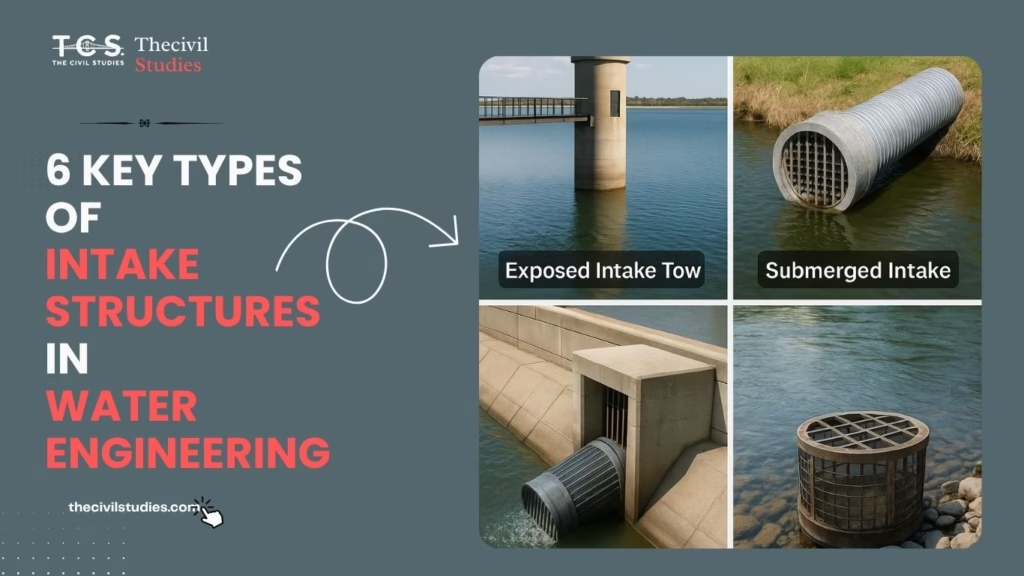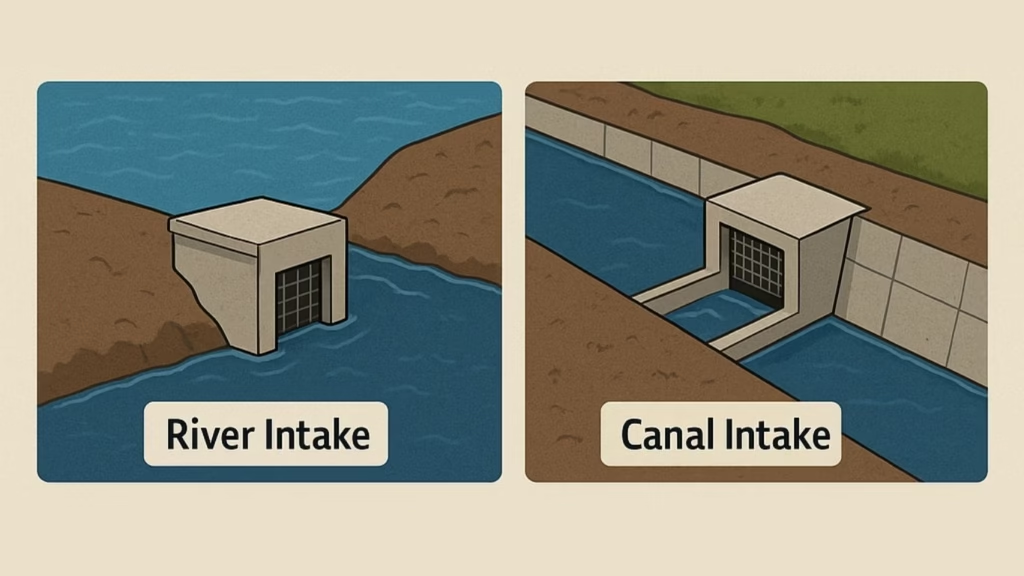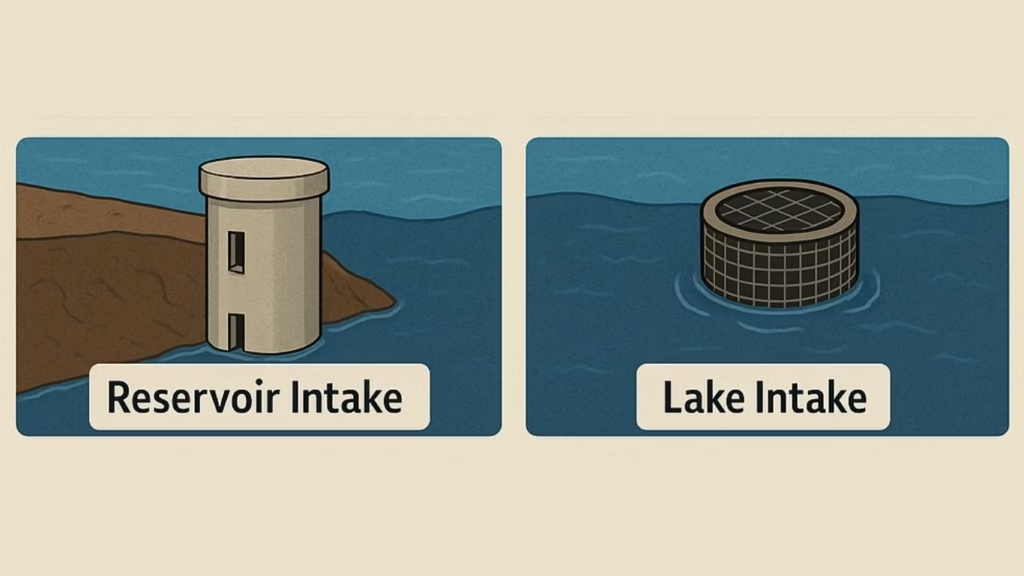
Types of Intake Structures in Water Resource Engineering – Explained with Real Use Cases
Water is the backbone of every civil infrastructure system—whether it’s drinking water supply, irrigation, or industrial use. But before water reaches treatment plants or pipelines, it needs to be collected from natural sources like rivers, reservoirs, lakes, or canals. That’s where intake structures come in.
An intake structure is the very first point where raw water is captured and directed into a controlled system. Think of it as the “gateway” between nature and engineered water supply systems. Its role may seem simple at first glance, but a poorly designed intake can cause everything downstream—literally and functionally—to fail. Let’s understand the different types of intake structures, how they are built, and where each type is used.
Why Does the Type of Intake Structure Matter?
Each water source behaves differently. Rivers flow fast and carry silt; lakes are stagnant and may have floating debris; reservoirs have varying water levels depending on storage. Designing the same intake for all sources would be a mistake. That’s why engineers choose intake structures based on:
- Source type and location
- Depth and seasonal variations
- Sediment load and water quality
- Maintenance needs and long-term performance
Let’s walk through the major types of intake structures, not just by definition—but by understanding why, when, and where they are used.



1. Submerged Intake Structures
Where they’re used: Deep lakes or rivers, especially when aesthetics or space constraints rule out surface structures.
These are built completely underwater. You won’t see them from the surface—they’re just a pipe with a protective screen or a rock-filled frame (called a crib) that sits on the riverbed or lake bottom. The idea is simple: draw water from a level below the surface, away from floating debris or oil films.
But why use a submerged intake?
Sometimes, authorities don’t want structures sticking out of the water—like near tourist lakes or navigation routes. Also, construction costs are often lower.
Challenges: Maintenance isn’t easy. Any blockage or damage below water can be hard to fix, especially if the intake is buried under silt or affected by aquatic growth.
Ideal for: Smaller water supply systems where access is not frequent, and water is relatively clean.
2. Exposed Intake Structures (Intake Towers)
Where they’re used: Reservoirs, man-made lakes, or calm riverbanks.
Unlike submerged intakes, these are visible from the surface. Imagine a tall tower rising from the reservoir, with several openings at different heights. Water enters from the reservoir into the tower and is conveyed further.
There are two variations:
- Wet Intake Tower: Water fills the tower and stays at the same level as the reservoir. It’s like a floating tank with side openings. Commonly called a jack well.
- Dry Intake Tower: The tower itself is dry—water flows directly into pipes through controlled inlets.
What makes them valuable?
These structures allow selective water withdrawal. If the top layer is polluted or warm (which often happens), water can be drawn from deeper, cleaner layers using lower-level inlets.
Maintenance is easier, and the structure is safe from silt accumulation since it’s built above the bed.
Used for: Large water supply systems, city-level infrastructure, hydropower, and multipurpose reservoirs.
3. River Intake Structures
Where they’re used: Directly on flowing rivers.
Rivers don’t stay calm. Their water level changes daily—and during monsoon, they flood. That makes designing river intakes tricky.
These structures are often built either:
- On the riverbank, if there’s enough depth, or
- Inside the river, using a protective well with screens, valves, and approach channels.
What’s the key engineering challenge?
Sediment. Rivers carry large volumes of sand and silt, which can choke the intake. So river intakes must include silt excluders, coarse screens, and sometimes even sediment chambers.
Ideal for: Municipal or industrial water supply systems that rely on perennial rivers.
4. Reservoir Intake Structures
Where they’re used: Near dams or storage reservoirs.
In most cases, engineers place the intake near the dam wall where water is deepest and flow is easy to direct through gravity. These structures usually resemble towers or galleries with multiple entry ports at different depths.
Why is this multi-level entry useful?
Water quality in reservoirs isn’t uniform. The top layers may contain algae, while the bottom layers could be cold and oxygen-deprived. By choosing which depth to draw water from, operators can maintain better water quality.
Engineers must also consider:
- Seasonal water level changes
- Structural load due to storage pressure
- Long-term durability
Common use cases: Drinking water supply systems, hydropower plants, irrigation reservoirs.
5. Lake Intake Structures
Where they’re used: Natural lakes and artificial lakes in cities or semi-urban regions.
Lake intakes are often submerged but come with protective framing—typically made of timber or concrete cribs filled with rocks. The idea is to draw water from a location that’s away from both the lakebed (to avoid sediment) and the surface (to avoid floating scum).
What makes them different?
Lakes are prone to thermal stratification—meaning the top and bottom layers can have very different temperatures. Intakes must be placed at mid-depth to avoid poor-quality water.
Also, wave action can damage unprotected intakes—so design must include wave-dampening features.
Used in: Urban water supply schemes or small towns near freshwater lakes.
6. Canal Intake Structures
Where they’re used: Along irrigation or supply canals.
These are the simplest and most cost-effective intake structures. Built into the canal wall (often lined canals), they include a screened chamber and an outlet pipe or gate to divert water.
Why are they practical?
- The flow is already controlled (unlike rivers).
- Water quality is often better due to prior regulation.
- Construction and operation costs are low.
However, silt accumulation and weed growth can still affect functionality, especially during irrigation seasons.
Ideal for: Agricultural irrigation systems, small community water supplies, and townships using canals as sources.
Key Components Found in Most Intake Structures
No matter the type, most intake systems will include:
- Screens or grilles to block debris and fish
- Trash racks for larger floating objects
- Valves or sluice gates to control water entry
- Sediment traps or chambers to remove silt
- Pumps or gravity pipelines to convey water downstream
The specific components and configurations depend on source conditions and system design.
Important Design Considerations
When designing an intake, engineers consider:
- Hydraulic Conditions: Flow rate, pressure, head loss, and turbulence must be minimized.
- Water Quality: Sediment, temperature, and biological content influence intake depth and location.
- Maintenance Access: Can the intake be inspected and cleaned regularly?
- Environmental Impact: Fish-friendly screens and ecological protection may be required.
- Safety & Structural Integrity: The intake must withstand floods, waves, or even ice (in colder regions).
Quick Comparison Table
| Intake Type | Used In | Special Features | Challenges |
|---|---|---|---|
| Submerged Intake | Lakes, Deep Rivers | Fully underwater, visually hidden | Hard to inspect and clean |
| Exposed Intake Tower | Reservoirs, Calm Rivers | Multi-level inlets, easy maintenance | Costlier, requires good planning |
| Wet Intake Tower | Dams, Reservoirs | Matches water level, suitable for jack wells | May collect debris at top |
| Dry Intake Tower | Reservoirs | Controlled draw through valves | Requires strong structural integrity |
| River Intake | Perennial Rivers | Handles flow variation, includes silt control | Needs regular desilting |
| Reservoir Intake | Near Dam Walls | Draws from different levels, steady supply | Must manage pressure and sediment |
| Lake Intake | Natural or Artificial Lakes | Avoids surface and bottom pollutants | Sensitive to algae and stratification |
| Canal Intake | Irrigation Canals | Easy to build and operate | Sediment and weed blockage |
Conclusion – Intake Structures in Water Resource Engineering
Intake structures may seem like a small part of the water supply system, but they define the quality and reliability of the entire downstream process. Choosing the right type, designing it for local conditions, and ensuring maintainability are key to long-term success.
Whether you’re working on a city-scale water treatment plant or a rural irrigation scheme, understanding how these structures interact with the natural water body is crucial. Well-designed intakes reduce energy consumption, improve water quality, and minimize environmental disturbance—making them a core concern in civil and environmental engineering.




